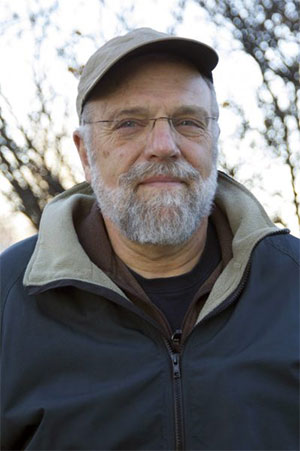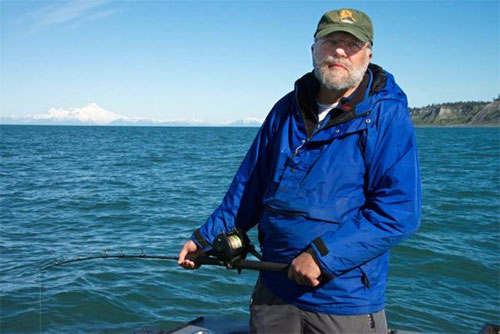
Marine agent draws on experience to advise AlaskansBy PAULA DOBBYN
September 04, 2017
Raised near Seattle, Johnson has been a professor at UAF’s College of Fisheries and Ocean Sciences and one of Alaska Sea Grant’s marine advisory agents since 1991. A longtime commercial fisherman and charter operator, Johnson’s career has taken him to Ketchikan, Sitka, Dillingham, Homer and, for nearly the last decade, Anchorage. Before joining UAF, Johnson lived in Prince Rupert, British Columbia, working as a correspondent for the Canadian Broadcasting Corp. and writing for trade publications. While living in Prince Rupert, Johnson decided to pursue his dream of being a commercial fisherman in Alaska. He sailed a dory hand troller made of plywood to Ketchikan, got his permit, and dropped hooks and lines. Johnson was still plugging away on his master’s thesis in marine resource management at the time. “I wrote my thesis on a manual typewriter by a kerosene lamp in a cabin near Behm Canal,” Johnson said. The channel separates Ketchikan, on Revillagigedo Island, from the mainland. The island, like most of Southeast Alaska, lies within the Tongass National Forest, which covers an area roughly the size of West Virginia. After fishing and freelancing magazine articles in Ketchikan, Johnson moved to Sitka, then a scenic town of fishermen, pulp mill workers, writers and artists on the outer coast. From there, Johnson was hired by UAF to serve as the marine advisory agent in Dillingham, a fishing hub in western Alaska. Johnson felt at home amid the hustle and bustle of Dillingham’s fishing scene. As a marine advisory agent, he helped fishermen learn to comply with the Commercial Fishing Industry Vessel Safety Act, provisions of the Marine Mammal Protection Act and other requirements. He taught workshops on how to make boats more energy efficient, and how to operate them as safely as possible. Johnson also ran a walrus-viewing charter company on the Bering Sea coast during summers. Johnson spearheaded Alaska Sea Grant’s approach to climate change — helping Alaskans find resources to adapt to shrinking glaciers, retreating sea ice, shoreline erosion, melting permafrost and other impacts. Several years ago, Johnson worked with local residents in Shaktoolik to develop a climate change adaptation plan that has been used as a model by others across the state. “When I was in Dillingham, I had people walking into my office every day, several times a day, or calling or emailing me. My rule was no stakeholder, no client goes away unserved,” Johnson said. “If they contacted me, I put everything aside and got answers to their questions, or at least referred them to someone who could provide answers.” While in Dillingham, Johnson also started studying salmon markets and writing publications to help fishermen understand factors that influence fish prices. He edited what many consider to be the single best resource on directly selling seafood to buyers. “Fishermen’s Direct Marketing Manual” is currently in its fourth edition, and a new edition is due out this fall. Johnson has authored 35 publications for Alaska Sea Grant, including books, how-to bulletins, posters, brochures, websites and newsletters to assist Alaska commercial and recreational fishermen. He regularly speaks on marine resource issues in Alaska communities. In 2016, he was invited to speak on climate change effects on commercial fishing in Alaska at more than 10 events.
Johnson recently responded to requests for help from an Alaska Native village corporation for help to address a growing rat infestation. He is the author of “Rat Control for Alaska Waterfront Facilities,” a guide for planning how to get rid of rats or control their numbers. “His depth of knowledge on many coastal subjects in Alaska is vast and well researched,” said Paula Cullenberg, director of Alaska Sea Grant. “He specializes in taking technical information and making it understandable to a wide range of Alaskans. His writing has left a substantial mark on our program.” Johnson is currently working on a report and handbook on boatyard health and safety. Down the road, he intends to focus more on science communication. He plans to help bridge the gaps between how scientists talk and how non-scientists listen. “You see these presentations every year at science symposiums where the scientist stands up and says, ‘Here is what I did, here’s the methodology, here’s the data, here’s my conclusion,’ and that’s a good format for one scientist communicating to another scientist or to people in their specialty who care about the same questions,” he said. “But, generally speaking, it doesn’t do much for the public who is paying for the research or for the industry whose successes or failure may be dependent on the results.” When he’s not working or spending time with his family, Johnson still finds lots of time to be on the water, although no longer as a commercial fisherman or charter operator. “I’ve got three paddleboats in my garage and a small yacht down in Homer,” he said. “I like to be outdoors.”
Representations of fact and opinions in comments posted are solely those of the individual posters and do not represent the opinions of Sitnews.
|
|||||

